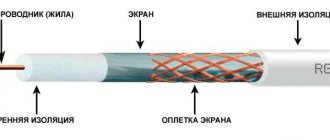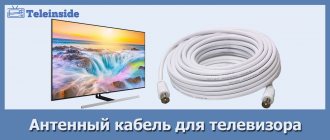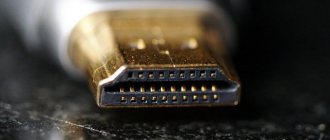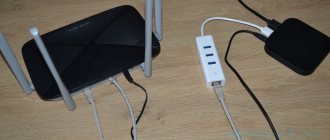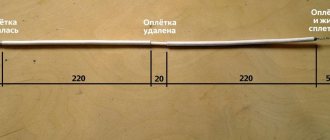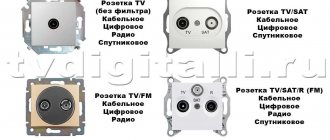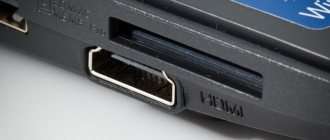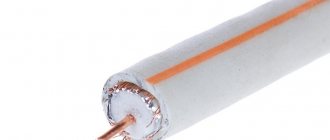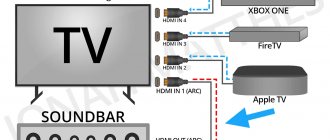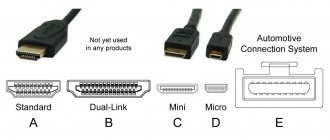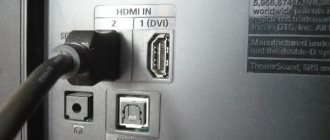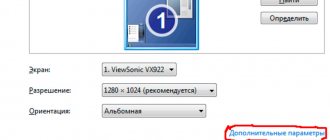The IT technology industry does not stand still, but, on the contrary, is developing dynamically. Almost every day new devices appear that make everyday tasks much easier. Particular attention should be paid to the synchronization of television equipment and computer equipment.
To connect a laptop or PC to a TV, the HDMI interface is often used. This TV cable is significantly superior to other available cords, such as VGA or tulips.
Despite the fact that this method of synchronizing a laptop and TV has been used for quite a long time, few people know according to what criteria an HDMI cable is selected. In fact, it is extremely easy to get confused and make mistakes. Especially if you have no idea what meaning is hidden behind this English abbreviation.
High Definition Multimedia Interface or HDMI is a multimedia interface that provides the transmission of the highest quality video content and multi-channel digital audio signals.
The terminology is, of course, good, but let’s figure out how HDMI is better than conventional tulips. The fact is that using old interfaces, you will not be able to broadcast images with maximum quality to the TV screen. Therefore, to watch movies in Full HD, you should use HDMI and not any other cable.
If we compare this interface with DVI, it will also be more advantageous. Firstly, it is compact. Secondly, it is equipped with copy protection.
We are convinced of the relevance of the cord, but how to choose it? Let's consider the main criteria:
- version;
- price;
- length;
- thickness;
- material.
In the future, we will consider these criteria in detail and give specific recommendations for choosing a wire, but now we will analyze the areas of use of the cord.
Choosing the best HDMI cable
While HDMI cables may look similar, they can all vary significantly. There are several types of HDMI connectors, for now we'll look at standard HDMI with Type A connectors. There are also several different cable standards that provide throughputs from below 5 gigabits per second (Gbps) up to 48 Gbps. HDMI cables can support a number of different features and standards.
We've reviewed several HDMI cables with a variety of TVs, monitors, game consoles, laptops, and computers.
Instructions for connecting Android smartphones
By connecting your phone, you can view photos, watch videos or play games - all of which will be displayed on the TV screen. There are many options for managing content through your TV. It all depends on the phone model and operating system. In this case, let's look at how to connect an Android phone to a TV using an HDMI cable.
To connect you will need a TV and smartphone, an HDMI cable or an MHL adapter. Some time ago, major phone manufacturers equipped their devices with a mini HDMI port. Over time, well-known brands began to abandon this idea. The presence of a port significantly increased the cost of gadgets. Therefore, all modern mobile devices now have a USB connector.
If your smartphone does have a port for an HDMI cable, you need to follow several steps to connect.
- On your TV you need to go to settings. In the signal source menu, select the desired item – HDMI.
- Then the mobile gadget is connected using an HDMI cable.
- Next, automatic image viewing should begin. If this does not happen, you need to open the phone settings and specify the required resolution frequency.
When connecting your phone via HDMI, you need to take into account that the device will not charge. When using the gadget for a long time with a TV, you should connect the charger.
How to choose an HDMI cable?
The first HDMI standard was released in 2002, and there have been several updates over the past couple of decades. To ensure the best picture and sound quality, and to take full advantage of the features your devices offer, you need to purchase the right HDMI cable.
Read: How to adjust your TV screen?
"The main thing people need to ask themselves is what HDMI features they want to support and what cables can support those features, and then perhaps if they want to be protected from possible hardware and feature upgrades in the future," says VP of Marketing , HDMI Licensing Administrator. “And make sure that the cables are from licensed HDMI manufacturers and that their products are tested and certified and correctly use the HDMI trademarks and are not unlicensed or counterfeit products.”
Connecting your phone to TV using micro (mini) HDMI
Not long ago, many Android phones included an HDMI port in their functionality. This is not a full-size connector, which can be found on TVs and laptops, but a mini or micro HDMI port.
Micro HDMI connector on a mobile phone. If you own such a smartphone, then all you need to do is buy the appropriate miniHDMI (microHDMI) cable. It can be purchased on Aliexpress or domestic online stores. It is enough to connect one plug of such a cable to your phone, the other to the TV. And then select the appropriate signal source on your TV.
Micro HDMI to HDMI cable
All you have to do is launch your favorite application (photo, video) and enjoy its display on the big screen. If the image is not displayed, or is displayed incorrectly, then in earlier models of TVs it is worth setting the appropriate image settings.
Set the appropriate video signal format.
Which HDMI cable standard should I choose?
While HDMI versions have their own numbering, the HDMI Licensing Center has created its own, slightly confusing nomenclature, which is described on the HDMI licensing website. All you really need to know is that certified cables come in the following varieties:
- Standard: Tested for reliable 1080i or 720p video transmission
- High Speed: Designed and tested to handle video resolutions of 1080p and above, including advanced display technologies such as 4K@30Hz, 3D and Deep Color
- Premium High Speed: Designed and certified for ultra-reliable performance for 4K/UltraHD, including advanced features such as 4K@60Hz, HDR and expanded color spaces
- Ultra-Speed: Supports all HDMI 2.1 features, including uncompressed 8k@60Hz and 4K@120Hz
While standard and high-speed cables are great for some applications, since the price difference is negligible, we recommend always choosing premium high-speed cables.
Read: Thunderbolt 3, what is it and how does it differ from USB C
It's also important to note that while you can purchase some HDMI cables that appear to support the Ultra High Speed standard, the testing specification has not yet been released, so no Ultra High Speed cables have been certified as of this writing.
How to connect your phone to TV via USB
A USB - Universal Serial Bus port is found on the back or side of most LCD or plasma TVs. If the model does not support wireless data transfer technologies, you can connect your smartphone to your old TV via a cord. For convenience, we recommend purchasing a universal adapter with different ports: USB Type-C on one end, HDMI, VGA, DVI, Display Port or miniDP on the other.
What to do:
To connect your phone to your TV via USB, take a cord from the charger or buy a simple cable with an adapter.
- Connect the adapter to your TV and smartphone. If connected correctly, a charging signal should appear on the phone screen.
- Set your TV to external file reading mode so that it recognizes your phone as an external drive or flash drive.
- On the remote control, press the Source, Multimedia, USB, Home button (depending on the model).
- In the list on the screen, find the name of the phone as a source of media files and indicate their type - photo, music or video.
- On Android phones 6.0 and higher, you need to select the line “Transfer files” or “Transfer photos” from the list on the phone screen. Folders with files from the smartphone’s memory or SD card will appear on the TV screen.
How much should I spend on an HDMI cable?
While different HDMI cables will support different bandwidths and features, the signal is digital, so one cable will work and the other won't. If you compare two certified Premium high-speed cables, they should work exactly the same, even if one costs 500 rubles and the other 5,000 rubles.
Sometimes more expensive cables are more durable, which may be worth considering if you're going to be plugging and unplugging them frequently. You'll also pay more for a longer cable, but for the most part there's no reason to pay that much.
Wired methods
You can tell which wires, it’s the 21st century, bluetooth and wi-fi have existed for a long time, and in general the whole world is rapidly abandoning boring laces. I understand that it sounds like I want to bring back the "ancient ages", but that's not the case.
MHL adapter
An HDMI cable allows you to avoid delays in “picture jerking” when broadcasting the screen to a TV. And this can be relevant, for example, in games, dynamic films, and in work situations. Using an OTG or MHL adapter allows you to expand the standard capabilities of your smartphone: connect a keyboard, mouse, other peripherals, and charge the battery. In fact, you can use your mobile phone as a system unit, and the TV will act as a monitor.
In general, a wired connection has still not lost its relevance. But if for Android you can use an OTG or MHL adapter, then for iPhone you will have to buy a Lightning to HDTV Cable Video and Charge Plug And Play adapter with an HDMI connector. Now the prices for such accessories have dropped very much, so you don’t have to shell out 5,000 rubles for a plastic box.
SlimPort
Another cable connection option is through an obsolete SlimPort device. The principle of operation is similar to MHL, but there are versions for DVI, DisplayPort monitor and for the VGA input of the projector.
How to choose the correct HDMI cable length?
You should aim to buy a cable that is as short as possible for your needs. The shorter the cable, the less chance of signal degradation. Shorter cables will also look cleaner, and you won't have an unsightly loop of extra cable to hide behind your TV.
However, make sure the cable has enough extra length to allow easy connection without putting strain on the port. Guessing at the right length is risky, so use a tape measure and add some length. Cable thickness is measured in AWG, with lower numbers indicating thicker cables.
Wireless methods
There are completely free ways to display an image on a large TV screen from any phone. Let's figure it out.
Miracast
Miracast is a wireless analogue of an HDMI cable. To duplicate the display image, on an Android smartphone go to the “settings” - “connections” - “broadcast” menu, then press the “menu button” (top right, but the interface may differ), activate the function and wait 10-20 seconds. Basically, the technology is supported by all modern Smart TVs, both on Android and Tizen.
On some smartphones, “miracast” may be in the curtain and called differently, for example, “Wireless monitor”, “screen mirror”, “mirror shader”, “broadcast”; on Samsung this function is called “smartview”. In general, if you don’t find the menu in the Android settings, check the curtain.
If you have an iPhone, we recommend using AirPlay; essentially, if you don’t go into details, it’s the same thing. More details about this method below.
But Miracast has its own characteristics:
- When projecting an image onto a TV, you cannot lock your smartphone, otherwise the TV screen will go dark along with it,
- There is no multitasking, that is, you cannot broadcast a movie on TV and at the same time sit on VK or play a game. Friends and family will be aware of your correspondence, pop-up messages and other data.
Chromecast
An excellent option, but let’s make a reservation right away: in no case should you confuse the Chromecast technology and the Google Chromecast set-top box, these are completely different things. Google chromecast is simply the name of one of the many devices that support chromecast technology.
Chromecast technology supports a lot of different devices from Xiaomi, Samsung, Google to all sorts of Chinese no-names. The main difference from Miracast is that the image is not duplicated on a smartphone and TV. Technically, the mobile phone acts as a mega-convenient control panel (rewind, pause, forward, backward, etc.), since it simply “transmits the video link” to the TV without taking part in the streaming process. While watching the video, you can safely browse social networks without worrying that your correspondence will be “burned.”
To find out if your TV supports chromecast technology, connect your phone and TV to the same Wi-Fi network (one router, so that the IP addresses are from the same subnet). On a cell phone, in an application, for example, Youtube, this icon should appear.
You can use chromecast not only from a specific application, try calling Google Assistant on your phone and asking it to turn on the video on your TV. The assistant will find the desired video on the Internet and transmit it to the TV via Wi-Fi.
You may have noticed that the chromecast icon can be found not only on a smartphone, but also on a computer, in the Google Chrome browser. In the same way, find a movie on your laptop, then click on the chromecast icon (in the settings at the top right) and continue watching on your TV. Just like in the case of a telephone, after this you can turn off the laptop altogether and put it on the shelf. The PC is no longer involved in the process; the TV “pulls” the material directly from the site.
Best HDMI Cables
Vention HDMI cable
New generation Vention digital cable for connecting video source and display device. The Ethernet channel allows multiple devices to work on an Ethernet network, without the need to connect additional wires, and directly exchange content at speeds of up to 100 Mbit/s...
The cable has a bandwidth of up to 18 Gb/s, supports Ultra HD 4K resolution (2160p), 3D capabilities, Blu-ray, and also supports more than 8 channels of audio. The presence of an audio return channel will eliminate the need for a separate wire to transmit audio to the receiver from a TV or other device that is both an audio and video source.
Atcom High speed HDMI cable
The ATCOM HDMI (HIGH SPEED) cable is designed to transmit high-quality digital audio/video signals. Used to connect to many new generation devices: TVs, computers and laptops, monitors, multimedia players, recorders, game consoles, video cameras, and other video devices that have the appropriate connector.
The cable contacts and connectors are gold-plated, which ensures high-quality image and sound, cable shielding ensures noise immunity, and the cable is round in shape.
AudioQuest HDMI Pearl Cable
The Pearl HDMI cable series embodies all the key components of AudioQuest's cable design philosophy. It uses solid longitudinal-fiber copper conductors, solid high-density polyethylene insulation and precision geometry. Special attention is paid to getting the best performance possible from HDMI, and AudioQuest HDMI cables truly take audio quality to the next level.
All AudioQuest HDMI cables up to 10 meters in length offer a maximum HDMI data transfer rate of at least 10.2 Gbps and are certified for high-speed Ethernet. This means that all AudioQuest cables up to 10 meters in length are capable of carrying 100% of the data required to play all existing audio/video content via HDMI, including high-definition multi-channel audio content, 1080p and 4k video content, and 3D video content from Blu-ray Discs. All AQ HDMI cables are capable of transmitting 100% of the data required to operate 120Hz, 240Hz and 600Hz displays.
AudioQuest HDMI Forest Cable
The AudioQuest Forest HDMI cable is created using the company's most advanced technologies and selected materials. The cable can be used in modern home theaters and AV systems that use the latest video and audio formats.
The AudioQuest Forest HDMI cable uses a solid, long-crystalline copper conductor that does not distort the transmitted signal. To increase the bandwidth required for digital data transmission, the conductor is coated with a layer of silver. The coating thickness is 0.5% of the total cable cross-section, and, according to the calculations of the company's engineers, this is quite enough to obtain the required characteristics. At the same time, such coverage does not have a significant impact on the cost of the cable, which remains affordable for most users.
The cable is equipped with connectors in molded cases that have gold-plated contacts. With superior technical specifications, AudioQuest Forest HDMI fully meets the requirements needed to deliver full 4K Ultra HD video and multi-channel HD audio. In addition, the cable supports Ethernet network interface and ARC audio return channel. In general, this model provides digital signal transmission at speeds of up to 18 Gb/s.
We use Wi-Fi Direct
The advantage of this technology is that setting up a home Wi-Fi network and registering both devices in it is not required - the gadget connects to the TV via Wi-Fi directly. The important thing is that both devices must support this feature. “Connect” happens like this:
- Wi-Fi Direct runs on the gadget. The user needs to follow the path “Settings” “Wireless networks and connections” “Wi-Fi Direct”. You should click “Activate” or “Ok” (depending on the model).
- The function starts on TV. You need to go to the menu, select “Network” and find Wi-Fi Direct in the list of options. After activating the function, a list of devices available for connection appears - from the list you should select the smartphone that was configured earlier.
- The smartphone receives a request to confirm the connection. Just click “Yes” and use Wi-Fi Direct for your pleasure.
